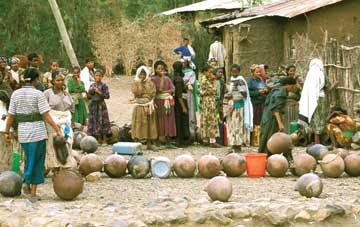|
FEATURE
Drinking Water for All: A 21st Century Challenge
Peter Rogers
 |
| Above and below: Near Alem Kitmama, Ethiopia, and across Africa and much of the developing world, water is a precious commodity. Providing safe potable water supplies is a nonstop challenge, and will only become more of a challenge as the climate changes. Photographs are copyright: WHO/P. Virot. |
 |
In 1995 Peter Gleick of the Pacific Institute announced seven sustainability criteria for water; among these were concerns for human health, ecosystem health, long-term renewability of fresh water, and social equity in access. These remain sensible goals for water management. Yet, the word “sustainable” is possibly the most overused and least understood word in the lexicon of the development community. From the world of science, we know for sure that nothing that we do can ever be ultimately sustainable. This does not, however, mean that we cannot develop water systems that last for centuries, even millennia. Remnants of ancient Roman water systems are still functioning in some Mediterranean countries, and even more ancient groundwater systems still function in some Middle Eastern countries.
It might be more useful, however, to define shorter timescales for sustainable water systems. Modern notions about water investments typically look to a 20- to 50-year future. These timescales have been generally acceptable given the traditional economic discount rates, the economies of scale inherent in building excess capacity, and the assumption that climate won’t vary across that time frame.
Is the Resource Adequate?
It should be made clear at the outset that the likelihood of running out of potable water is very remote, simply because humans won’t let it happen. Water is a fungible resource that can be allocated and used by many persons, sectors, and ecosystems, all competing for the same resource base. It just so happens that humans place a very high value on water for drinking purposes, so any intelligent discussion of sustainability must therefore address the impact of human use across all sectors and users of the resource.
The current literature on physical water resources has focused on the near term, from 25 to 50 years from now. From a global point of view, enough of the resource is available in most places in the world, according to Sandra Postel of the Global Water Policy Project and colleagues, but population growth and climate change could considerably tighten the situation in coming decades.
Regions around the world face the problem to varying degrees, which include water shortage (less than 2,000 cubic meters per capita), water stress (less than 1,700 cubic meters per capita), water scarcity (less than 1,000 cubic meters per capita), and extreme water stress (less than 500 cubic meters per capita). The global average is about 5,000 cubic meters per capita. Using the medium-range U.N. population projections, the number of persons living in countries with water scarcity will rise from about 280 million in 2000, to 1 billion in 2025, and to 2 billion in 2050.
These numbers refer to all forms of water use, which include domestic, industrial and agricultural uses. The global per capita consumption of domestic water is expected to rise from about 30 to more than 50 cubic meters per capita in the next 25 to 50 years, though developed nations are already consuming more than 50 cubic meters per capita.
The Bad News
Discussions about potable water supplies around the world are usually framed as catastrophe scenarios, built around a set of seemingly incontrovertible facts: growing populations, rapid urban growth in poor countries, climate change and lack of proper governance.
 |
| The search for potable water is not limited to developing countries: Water wells in New Brighton, Minn., were found to be contaminated with chemical solvents from the Twin Cities Army Ammunition Plant in Arden Hills in July 1981. State of the art water treatment facilities were constructed to purify the water. Photograph is courtesy of City of New Brighton . |
With the world’s population continuing to grow, adding as many as 3 billion more people to the current population of 6 billion by 2050, there is obvious reason for serious concern about the ability of known water supplies to support such increases even at the inadequate levels of per capita supply that we currently have around the world.
Added to the problem of global growth is rapid urbanization in developing countries. The United Nations has predicted that 19 of the world’s 25 mega cities (more than 10 million inhabitants) will be in the developing world by 2025. This urbanization will exacerbate the potable water supply problem because dense populations increase the complexity and cost of water supply and sanitation, often to levels beyond the financial ability of many cities.
The impact of population on water demands, however, is not a linear relationship. More than 1 billion people are currently not served with an adequate supply of safe potable water, so in addition to meeting the demands of the new 3 billion, we will also have to provide potable water to this 1 billion people. Additionally, water is “income elastic,” meaning that increased income leads to increased per capita water use, so demand increases non-linearly with population. Furthermore, population increase also requires increased wastewater treatment, thereby further increasing the total cost of potable water.
Also adding to future concerns is that whatever the cause, Earth is slowly warming. Unfortunately, this warming makes predicting water availability very speculative. With increased temperatures, we expect increased evaporation from the ocean surface, which could increase the precipitation by as much as 15 percent.
We know, however, that increased temperatures over watersheds change the partition among snow melt, surface runoff, groundwater recharge and evaporation in a non-linear way. The specific result is site-specific and hard to predict. Also, the effects of increased evaporation and rainfall on snow levels and the countervailing change in temporal stream runoff due to temporal shifts in snow-melt water supply to rivers and lakes, are largely unknown (see Geotimes, December 2006). Uncertainties about the physical supply of water imply that we should follow a cautionary, conservative approach. This is referred to as the “precautionary principle.” Unfortunately, different people have different ideas as to how precautionary we should be.
For example, in February 2007, a National Academy of Sciences panel presented a report called The Colorado River Basin Water Management: Evaluating and Adjusting to Hydroclimatic Variability. Extending over 622,000 square kilometers in Wyoming, Utah, Colorado, New Mexico, Arizona, Nevada, California and Mexico, the Colorado Basin has been experiencing rapid population growth in recent decades, with Phoenix, Ariz., being the fastest growing city in the nation, and the population of Arizona expected to grow from 5 million inhabitants today to more than 15 million by 2025. The historical occurrence of severe periodic droughts in the Colorado Basin can be seen in the climatic records of river flows and tree rings going back to the 1500s, and the recently increasing temperatures will only intensify these historically severe droughts in the future.
Given the uncertainties about future water availability in the face of gradual warming, however, it might be prudent to plan, not necessarily build, for at least a 100-year timescale. Indeed this is what the Arizona legislature specified for its groundwater law: Developers inside the conservation zones have to demonstrate that they have sufficient water rights to meet the future water demands of new developments for at least the next 100 years. This may achieve mid-term sustainability, but not necessarily in the long run.
In another study, Charles Vorosmarty of the University of New Hampshire and colleagues compared forecasts contrasting the relative impacts by 2025 of climate change and population growth together (based upon the Third Assessment Report of the Intergovernmental Panel on Climate Change and U.N. population projections). They concluded that, compared to the impacts of population growth, the consequences of climate change were relatively minor.
In reality, however, both population growth and climate change will occur simultaneously. Under these joint conditions, severe potable water shortages could arise in many areas, particularly in Africa and parts of Asia where the resource is already stressed.
 |
| In some developing countries, such as India, a sodium hypochlorite (chlorine) solution is used to purify drinking water. Photograph is copyright: WHO/P. Virot. |
Poverty also has a major impact on water resources, specifically in the financial resources that can be mobilized to develop water supply infrastructure. The World Bank, the Global Water Partnership and others have estimated that an annual increment of about $50 billion is needed to meet the water and sanitation goals of the developing world. Typically, however, countries often spend the bulk of their capital funds in other sectors such as defense, roads and telecommunications. This persistent underfunding exacerbates the situation, particularly for potable supply to the urban poor.
The problem is not limited to developing countries. In 2003, the U.S. Government Accountability Office (GAO) estimated that over the next 20 years the United States would need to invest between $300 billion and $1 trillion just to keep the U.S. domestic water and sanitation systems up to their mandated quality standards. GAO attributed the huge financial needs to the “deferred maintenance” currently practiced by almost all large U.S. water utilities.
Increasingly we see that the major problem of water supply for existing populations lies in the lack of effective governance by national and local governments. This was the major theme expressed in the recent U.N. Development Programme Human Development report, Water for Life. Governance does not mean just the institutions themselves, but functioning institutions with effective interactions among civil society, politicians, and nongovernmental organizations. Lack of effective governance and institutions is not confined to developing countries; it is often the source of misallocations of water and financial resources in the developed world as well.
The Good News
Many different technical and scientific fixes exist that would enable humans to secure access to potable water and sanitation services for the next several generations. Such initiatives, ranging from waterless toilets to mega-urban treatment, recycling and reuse plans, involve the integration of potable water supply and the treatment of human and industrial wastewater.
Yet, in many countries, as much as 60 to 95 percent of water is consumed by irrigated agriculture. This fact is extremely important when looking toward future water supply management. Typically, a 10 percent reduction in irrigation water use would more than double the amounts of water available for domestic and industrial uses. The question then hinges on whether or not a 10 percent reduction in irrigation efficiencies could be achieved, or equivalent areas of rain-fed crops developed, at the same time agriculture expands to address population growth.
Advanced technologies are also important in developing potable water. One such technology is membrane filtration combined with reverse osmosis, which is revolutionizing the application of desalination (see Geotimes, October 2006). Large-scale plants are potentially cost-competitive with current urban supplies, with costs as low as 50 cents per cubic meter of water (about $1.80 per 1,000 gallons) and represent a potential solution for cities with access to saline water. While this does not give an instant solution to the problem in the developing world, it does indicate that reasonable, economically achievable technology can be used to address problems as they develop.
Economic and social fixes can help improve the sustainability of potable water supplies, such as pricing schemes that allow for cross-subsidization of consumption, which the poor can ill-afford, by charging relative to wealth to create social equity. Also, many market-based approaches, as well as regulatory and rationing systems, can aid the goal of sustainability. For example, allowing farmers to trade their irrigation water to high-income urban dwellers may make the entire system more sustainable because the higher values assigned to water will also make the farmers more efficient in its use.
In the end, the major reason for widespread dissatisfaction about water issues in developing countries stems from the vast numbers who have no access to adequate drinking water or sanitation. Whatever the actual numbers are, they represent a massive failure by national governments and the world community to deal with these issues, which involve human dignity more than economics.
In the end, it is economics, however, that drives the failure to meet water needs. It is simply beyond the financial capabilities of existing governmental and international agencies to cover the capital cost of providing conventional water and sanitation to the growing populations. Either large, new sources of funding will be needed, or the conventional views of water-borne sanitation will have to be changed toward well-known ecological sanitation practices that use little or no water. Low-cost ecological engineering breakthroughs are likely to revolutionize the supply of water and sanitation in the near future, but they aren’t a panacea. The solution to a sustainable, potable water supply will rely on a whole suite of approaches.
The potential for sustainable potable water supplies is a realistic goal, but one that will not come about under a laissez-faire governance regime. Active political involvement of all water stakeholders will be essential.
Links:
"Thawing ice shifts water cycles," Geotimes, December 2006
"Taking a Fresh Look at Desalination," Geotimes, October 2006
"Searching for Water in All the Right Places," Geotimes, May 2006
"Challenges to Clean Water Worldwide," Geotimes, May 2005
"Hijacking the Rio Grande: Aquifer Mining in an Arid River Basin," Geotimes, May 2004
"Western Aquifers Under Stress," Geotimes, May 2004

 Subscribe
Subscribe


